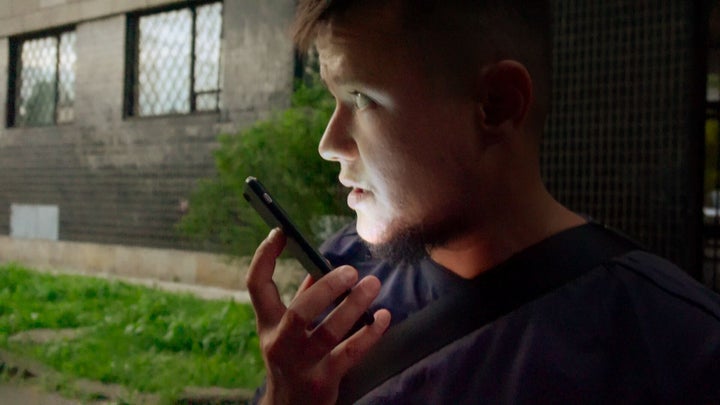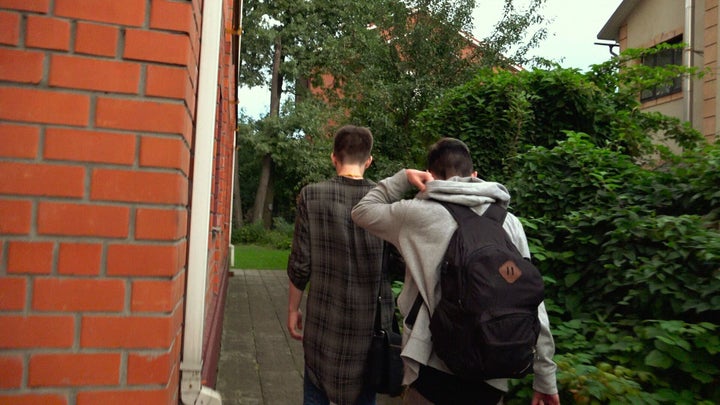“Tell me how critical the situation is and why you assume your father is a threat.”
Those are among the first words you’ll hear in the new documentary “Welcome to Chechnya.” The response comes via speakerphone. A woman says her uncle has discovered she is gay. If he tells her father, a government official in the southern Russian republic where gay people are systematically tortured, he might murder her. She isn’t sure how to flee without getting caught, hence the reason she’s seeking counsel from David Isteev, the person who initiated the call. He’s part of the Russian LGBT Network, an activist group that executes risky missions to help relocate oppressed Chechen queers to other parts of Russia, as well places in Eurasia and Canada.
Considering that the U.S. Supreme Court recently ruled that employers cannot discriminate on the grounds of sexual orientation and gender identity, it can be easy to forget how violent anti-queer intolerance remains in some parts of the world. “Welcome to Chechnya,” premiering Tuesday on HBO, is a striking reminder. Moreover, it introduces a revolutionary way to chronicle persecution without risking harm to already vulnerable victims.
What began as a police-led drug raid in 2017 resulted in a region-wide purge when authorities discovered gay photographs and text messages on a man’s phone. They beat him and coerced him into turning in other gay men, setting off a domino effect. Scores of people were publicly abused and arrested, prompting the formation of the activist coalition that “Chechnya” follows.

David France, the Oscar-nominated documentarian whose credits include “How to Survive a Plague” and “The Death and Life of Marsha P. Johnson,” first learned of the Russian LGBT Network in a July 2017 New Yorker article. Wanting to capture the crisis on film, France flew to Moscow to meet survivors who had been transferred to safe houses. He’d planned a weekend “fact-finding mission,” but wound up staying for a month. Before he knew it, cameras were rolling. France visited hideouts and tracked down refugees, estimating that 65% of the ones he approached agreed to participate with the understanding that their identities be concealed.
“Before I started making documentary films, I was a print journalist, and I have a great deal of foreign reporting experience in my past,” France said. “But I had never reported from Russia, so it was a crash course for me to understand the dynamics there and the risk that it takes to tell a story like this in Russia, and to develop what amounted to really extraordinary security protocols, both for myself and the team to make sure we are safe, and also for the people who we were visiting in their shelters to make sure nothing that we did would expose them or their location.”
That’s where the hardest work came in. The goal, France said, was to mask the participants so thoroughly that not even their own parents could recognize them. France had 20 months’ worth of footage by the time he started assembling the film, having left encrypted cameras in some of the safe houses that allowed refugees to document themselves.
The director assumed he’d use traditional visual-effects methods to anonymize everyone, namely rotoscoping, an animation technique that turns live-action material into realistic cartoons. But upon applying the rotoscoping, France discovered it wasn’t viable. “It either completely erased the humanity of the people whose stories I was telling, or it rendered them, unexpectedly, even more recognizable,” he said. “It kind of made them into caricatures of themselves.”
France spent a few months exploring various options, which ultimately led him to Ryan Laney, a VFX specialist who has worked on Hollywood blockbusters such as “Star Wars: Episode II — Attack of the Clones,” “Hancock” and “Ant-Man.” Laney said he is known as someone who finds “unorthodox” solutions to complicated effects problems. When he got a call in September 2018 from a colleague who’d been contacted by France’s production company, Public Square Films, Laney immediately wanted to help.
Laney and a small team spent nine months experimenting with ways to fashion a technology that camouflaged faces but still captured the real person’s expressions. The intent was for audiences to feel survivors’ every emotion as they escape Chechnya and transition to a new life, which traditional identity-obscuring procedures — think blacked-out faces and improbable voice disguises — wouldn’t allow for. The VFX producers landed on an automated version of what stunt doubles do on big movies. France recruited approximately two dozen local activists to stand in for the subjects in the film. On a soundstage in Brooklyn, Laney shot footage of those activists that could later be filtered onto refugee’s faces through computers.

“Our goal here was to create a journalistic tool,” he said. “Humans are really engineered to read faces, and when you’re telling a story with someone in shadow or behind a screen or with their face blurred out, there’s so much information that’s lost. The idea that a documentary filmmaker could tell the same story in a more compelling way seemed really powerful, but then we realized that not only will this help the documentary filmmaker — it will help the witness. If a witness has more confidence that their identity can be preserved, the more likely they’ll be to speak. It changes the dialogue for telling these stories.”
In conjunction with Dartmouth College’s neuropsychology lab, France commissioned a study to measure the effectiveness of the efforts. Participants watched a clip in which a subject’s face had been given several different VFX treatments, after which they scored the impact of each. Laney’s method rated just as high as imagery of the subjects without any effects at all. France then allowed each survivor featured in “Chechnya” to sign off on their new likeness before deeming the project complete.
The final results are astonishing. It’s not that you can’t tell there are effects while watching the film — it’s that they don’t matter. Every late-night absconding, every panicked moment and every sigh of relief comes through vibrantly, contrasting the grainy scenes of battery and torment that Chechen extremists consider keepsake trophies.
In the past, France’s documentaries have provided a sort of catharsis. “How to Survive a Plague,” which depicts the AIDS crisis, ends as a success story: Thanks to advocacy on the ground, that epidemic has dwindled, proving that society can overcome bigotry. There’s hope to be found in “Welcome to Chechnya,” but it doesn’t have the advantage of hindsight. This purge is still happening. According to the film’s postscript, the Russian LGBT Network relocated 151 people in its first two years of existence. But Ramzan Kadyrov, the leader of the Chechen Republic, continues to deny that queer people are suffering — a notion Russian President Vladimir Putin has endorsed. Adding insult to injury, U.S. President Donald Trump’s administration has not accepted any Chechen asylum seekers.
With the existence of “Welcome to Chechnya,” the humanitarian emergency is now impossible to deny.
“We wanted stories that really explained the facts on the ground and told the larger story of what it meant to survive that kind of torture and abuse, what it meant to be so forcibly dislocated from your homeland, and what it meant to be the activist who had sacrificed so much and put so much of their lives in danger to carry out this heroic work,” France said.
Calling all HuffPost superfans!
Sign up for membership to become a founding member and help shape HuffPost’s next chapter
Credit: Source link